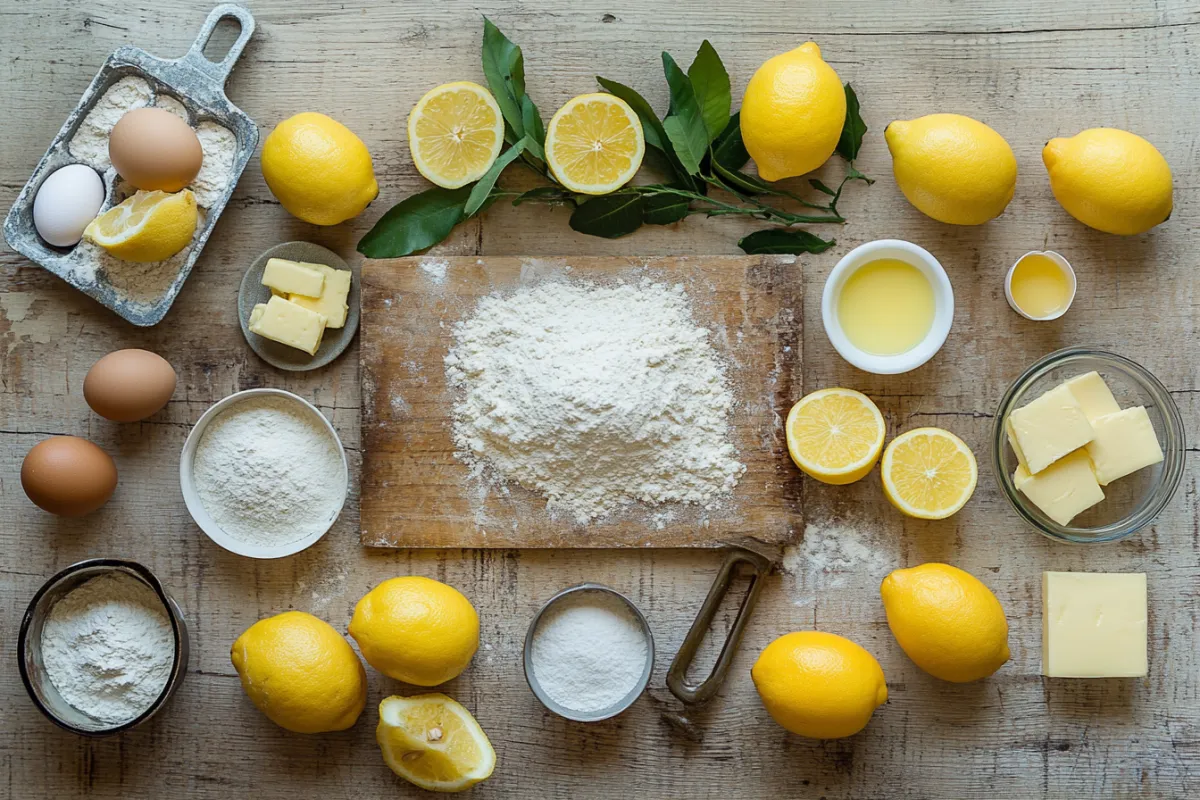Lemon bars are a beloved dessert known for their refreshing tang and delightful texture. Combining a buttery crust with a zesty lemon filling, these treats are a staple at picnics, potlucks, and holiday gatherings. But what exactly are lemon bars made of? In this comprehensive guide, we’ll explore every detail about lemon bars, including their ingredients, variations, preparation techniques, and much more.
Table of Contents
- Introduction
- Basic Ingredients
- Shortbread Crust
- Ingredients
- Preparation Steps
- Lemon Filling
- Primary Ingredients
- Preparation Steps
- Shortbread Crust
- Detailed Breakdown of Ingredients
- Flour
- Sugar
- Eggs
- Butter
- Common Variations and Substitutions
- Gluten-Free Options
- Dairy-Free and Vegan Versions
- Creative Flavor Variations
- How to Make Lemon Bars
- Step-by-Step Recipe
- Tips for Perfect Lemon Bars
- Serving and Storing
- Serving Suggestions
- Storage Tips
- Nutritional Information
- Healthier Alternatives
- FAQs
- Conclusion
Introduction
Lemon bars have a rich history in American cuisine, believed to have originated in the 1960s. Their bright flavor and simple preparation make them a favorite for both novice and experienced bakers. These bars have evolved over time, with numerous variations emerging, each showcasing individual creativity.
The vibrant taste of lemon bars evokes memories of summer days, making them a nostalgic treat for many. Their combination of sweetness and tartness is irresistible, providing a perfect balance that keeps you coming back for more.
In this article, we will delve into the key ingredients that make up lemon bars, different ways to customize them, and tips for creating the perfect batch. Let’s get started!
Basic Ingredients
Lemon bars typically consist of two main components: the shortbread crust and the lemon filling. Understanding these elements is crucial for mastering this dessert.
Shortbread Crust
The shortbread crust serves as the foundation for any great lemon bar, providing a rich, buttery flavor and a satisfying crunch.
Ingredients:
- All-Purpose Flour (2 cups): The main structural component of the crust, providing stability and texture.
- Unsalted Butter (1 cup, softened): Adds richness and a creamy texture. Using unsalted butter allows for better control over the saltiness of the dessert.
- Granulated Sugar (½ cup): Sweetens the crust and contributes to its crumbly texture.
- Salt (¼ teaspoon): Enhances the flavor of the crust and balances sweetness.
Preparation Steps:
- Mixing the Ingredients: In a mixing bowl, combine the flour, sugar, and salt.
- Incorporating Butter: Add softened butter and mix until crumbly. A pastry cutter or your hands can be used for this step.
- Baking the Crust: Press the mixture into the bottom of a greased baking dish and bake at 350°F (175°C) for about 20 minutes until lightly golden.
Lemon Filling
The lemon filling is where the real magic happens. This mixture provides the signature tang that makes lemon bars so delightful.
Primary Ingredients:
- Fresh Lemon Juice (¾ cup): Provides the essential tart flavor. Fresh juice is recommended for the best taste.
- Lemon Zest (from about 2-3 lemons): Adds an aromatic citrus flavor that enhances the overall profile of the bars.
- Eggs (4 large): Bind the filling together and provide richness.
- Granulated Sugar (1 ½ cups): Sweetens the filling and balances the acidity of the lemons.
- All-Purpose Flour (¼ cup): Helps thicken the filling and gives it a smooth consistency.
Preparation Steps:
- Whisking: In a separate bowl, whisk together the eggs and sugar until light and fluffy.
- Adding Lemon: Gradually mix in the lemon juice and zest until fully incorporated.
- Thickening: Stir in the flour until the mixture is smooth and free of lumps.
Once both components are prepared, the filling is poured over the pre-baked crust, and the dish is returned to the oven for further baking.
To understand more about the health benefits of lemons, check out Healthline. Lemons are rich in vitamin C and other antioxidants, promoting overall health.

Detailed Breakdown of Ingredients
Each ingredient in lemon bars plays a significant role in the final outcome. Let’s take a closer look at these components.
Flour
The choice of flour is critical for achieving the right texture.
- All-Purpose Flour: This is the most commonly used flour for both the crust and filling. It provides the necessary structure while remaining versatile.
- Gluten-Free Alternatives: For those with gluten sensitivities, almond flour or coconut flour can be substituted. Note that adjustments to the liquid content may be needed due to the differing absorbency of these flours.
Sugar
Sugar is essential for balancing the tartness of the lemon.
- Granulated Sugar: Primarily used in the filling for sweetness.
- Powdered Sugar: Often dusted on top after baking for aesthetic appeal and an extra hint of sweetness.
Eggs
Eggs play a crucial role in providing structure, moisture, and richness.
- Whole Eggs vs. Egg Yolks: Most recipes call for whole eggs, but using just the yolks can create a creamier texture, enhancing the overall richness of the bars.
Butter
The butter used in the crust not only adds flavor but also contributes to a flaky texture.
- Unsalted Butter: It’s recommended to use unsalted butter for more control over the final taste. This allows the natural flavors of the lemon to shine through without being overwhelmed by salt.
Common Variations and Substitutions
Lemon bars can be customized in numerous ways to cater to different dietary preferences or to experiment with flavors.
Gluten-Free Options
If you’re looking for a gluten-free version, consider these alternatives:
- Almond Flour: Provides a nutty flavor and a slightly different texture. Use about 1 ¾ cups of almond flour for the crust.
- Coconut Flour: Absorbs more moisture, so you may need to adjust the liquids in the recipe. Use about ½ cup of coconut flour and increase the butter slightly.
Dairy-Free and Vegan Versions
For those seeking dairy-free or vegan options:
- Plant-Based Butters: Substitute regular butter with vegan alternatives like coconut oil or vegan margarine.
- Egg Replacements: Use flaxseed meal (1 tablespoon mixed with 2.5 tablespoons of water per egg) or applesauce (¼ cup per egg) as binders.
Creative Flavor Variations
While traditional lemon bars are fantastic, don’t hesitate to experiment with different flavors:
- Berry Lemon Bars: Incorporate a layer of raspberry or blueberry puree into the filling for a fruity twist.
- Herbed Lemon Bars: Infuse the filling with fresh herbs like basil or mint for an unexpected flavor profile.
How to Make Lemon Bars
Creating lemon bars is an easy and rewarding process. Here’s a detailed guide to help you achieve success in the kitchen.
Step-by-Step Recipe
- Prepare the Crust:
- Preheat your oven to 350°F (175°C).
- In a mixing bowl, combine the flour, sugar, and salt. Cut in the butter until the mixture resembles coarse crumbs.
- Press the crust mixture evenly into the bottom of a greased 9×13 inch baking dish. Bake for about 20 minutes or until lightly golden.
- Make the Filling:
- In another bowl, whisk together the eggs and sugar until well combined and fluffy.
- Gradually stir in the lemon juice and zest, mixing thoroughly.
- Finally, stir in the flour until smooth and well incorporated.
- Combine and Bake:
- Pour the lemon filling over the pre-baked crust.
- Bake for an additional 20-25 minutes, or until the filling is set and a toothpick inserted in the center comes out clean.
- Allow the bars to cool completely before slicing them into squares.
Tips for Perfect Lemon Bars
- Use Fresh Lemons: Fresh lemon juice provides the best flavor. Avoid bottled juices whenever possible, as they can lack vibrancy.
- Cool Before Cutting: Allow the bars to cool completely, preferably chilling them in the refrigerator before slicing. This helps achieve clean edges.
- Zest with Care: When zesting lemons, avoid the bitter white pith beneath the skin for the best flavor.
Serving and Storing
Serving Suggestions
When serving lemon bars, consider garnishing with:
- A light dusting of powdered sugar for a classic presentation.
- Fresh lemon slices or zest for added decoration.
- A dollop of whipped cream or a scoop of vanilla ice cream to elevate the dessert experience.
Storage Tips
- Refrigeration: Store lemon bars in an airtight container in the refrigerator. They can last about a week, although they’re best enjoyed fresh.
- Freezing: Lemon bars can be frozen for up to three months. Wrap them tightly in plastic wrap and then in foil to prevent freezer burn. Thaw in the refrigerator overnight when you’re ready to enjoy them.
Nutritional Information
While lemon bars are a delightful indulgence, it’s beneficial to be aware of their nutritional content. Here’s a general breakdown:
- Calories: Approximately 200-250 per serving, depending on the recipe and portion size.
- Nutrients: High in vitamin C from the lemons, which can offer antioxidant benefits and support immune health.
Healthier Alternatives
If you’re looking to indulge without the guilt, consider these healthier alternatives:
- Reduce Sugar: Experiment with using less sugar or substituting natural sweeteners like honey or maple syrup.
- Add Whole Grains: Substitute some all-purpose flour with whole wheat flour to increase fiber content.
FAQs
What are lemon bars supposed to taste like?
Lemon bars should have a delightful balance of sweetness and tartness, complemented by a buttery crust.
Can I use bottled lemon juice?
While fresh lemon juice is preferred for optimal flavor, bottled lemon juice can be used in a pinch.
Are lemon bars gluten-free?
Traditional lemon bars are not gluten-free, but you can easily substitute gluten-free flours to make them suitable for those with gluten sensitivities.
Can I make lemon bars ahead of time?
Yes, lemon bars can be made a day or two in advance. Just be sure to store them properly in the refrigerator.
What’s the best way to cut lemon bars?
For clean cuts, use a sharp knife and wipe it with a damp cloth between cuts.
Conclusion
In conclusion, lemon bars are a delightful dessert that combines the perfect balance of sweet and tart flavors. With a simple list of ingredients—flour, butter, sugar, eggs, and fresh lemons—they can be easily adapted to fit various dietary needs and preferences.
Whether you’re baking for a special occasion or simply want a refreshing treat, lemon bars are sure to impress. Their versatility and nostalgic flavor make them a timeless classic that deserves a place in every dessert lover’s recipe collection.
Feel free to experiment with the ingredients and discover your ultimate lemon bar recipe! Embrace the bright, sunny flavors of lemon bars and share this classic dessert with friends and family for a taste of nostalgia.


